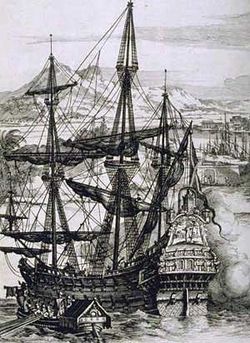غليون (سفينة)
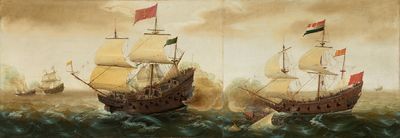
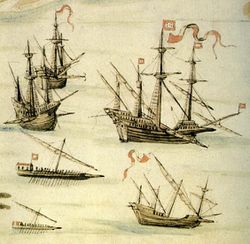
الغليون Galleons كان سفينة شراعية كبيرة، أول من استخدمها كانت الامبراطورية الاسبانية كسفينة شحن مسلحة ولاحقاً استخدمتها دول أوروپية أخرى من القرن 16 إلى القرن 18 أثناء عصر الشراع وكان الوحدة الأساسية المستخدمة كسفن حربية حتى الحروب الإنگليزية الهولندية في منتصف ع1600.[2] الغليونات، عموماً، كانت تحمل ثلاث صواري أو أكثر مع lateen fore-and-aft rig on the rear masts, were carvel built with a prominent squared off raised stern, and used square-rigged sail plans on their fore-mast and main-masts.
Such ships were the mainstay of maritime commerce into the early 19th century, and were often drafted into use as auxiliary naval war vessels—indeed, were the mainstay of contending fleets طوال معظم الـ 150 عاماً من عصر الاستكشاف—قبل أن تجلب الحروب الأنگلو-هولندية السفن الحربية purpose-built ship-rigged التي، بعد ذلك، هيمنت على الحروب البحرية في بقية عصر الشراع.
. . . . . . . . . . . . . . . . . . . . . . . . . . . . . . . . . . . . . . . . . . . . . . . . . . . . . . . . . . . . . . . . . . . . . . . . . . . . . . . . . . . . . . . . . . . . . . . . . . . . . . . . . . . . . . . . . . . . . . . . . . . . . . . . . . . . . . . . . . . . . . . . . . . . . . . . . . . . . . . . . . . . . . . .
أصل الاسم
The term galleon, "large ship", comes from Spanish (Castilian) galeón, "armed merchant ship", from Old French galion, "little ship" (13c.), from Portuguese galeão, "war ship", from Byzantine Greek galea, "galley" + augmentative suffix -on.[3] Another possible origin is the Old French word galie, meaning "galley;"[4] also from Byzantine Greek galea.[5] The galea was a warship of the Byzantine navy, and its name may be related to the Greek word galeos, "dogfish shark".[6] The term was originally given to certain types of war galleys in the Middle Ages. The Annali Genovesi mentions galleons of 80, 64 and 60 oars, used for battle and on missions of exploration, in the 12th and 13th centuries. It is very likely that the galleons and galliots mentioned in the accounts of the crusades were the same vessels.[بحاجة لمصدر] In the early 16th century, the Venetian galleoni was a new class of galley used to hunt down pirates in the Mediterranean.
Later, when the term started to be applied to sail-only vessels, it meant, like the English term "man of war", any large warship that was otherwise no different from the other sailing ships of the time.[بحاجة لمصدر]
بناؤه
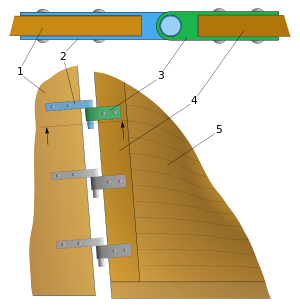
السمات المميزة
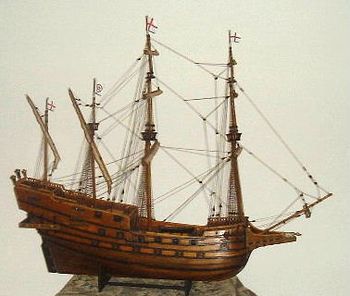
• a 'shorter & second' Bonaventure mizzen: the fourth mast on larger sixteenth century galleons, typically lateen-rigged and shorter than the main mizzen,
• a short Mizzen-mast (the mast immediately aft of the main-mast; the third mast, also typically shorter than the fore-mast), but on Galleons were Lanteen Rigged.
• Main-mast: typically, the tallest mast (and on vessels with more than three masts the most centrally located).
• Fore-mast: typically, the second tallest mast (and on vessels with more than three masts the second most tall) located first after the ship's bow.
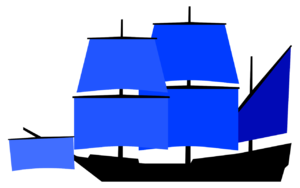
انظر أيضاً
الهامش
- ^ [1] Galeão – Navegações Portuguesas by Francisco Contente Domingues (البرتغالية)
- ^ Lane, Kris E. Pillaging the Empire: Piracy in the Americas 1500-1750. M. E. Sharpe, 1998.
- ^ http://www.etymonline.com/index.php?term=galleon
- ^ "Collins Concise English Dictionary". Retrieved 21 Feb 2014.
- ^ Anderson, Roger Charles, Oared fighting ships: From classical times to the coming of steam. London. 1962. p. 37-39
- ^ Henry George Liddell & Robert Scott Galeos, A Greek-English Lexicon
مراجع
- Alertz, U. (1991) Vom Schiffbauhandwerk zur Schiffbautechnik : die Entwicklung neuer Entwurfs- und Konstruktionsmethoden im italienischen Galeerenbau (1400-1700), Hamburg : Kovač, ISBN 3-925630-56-2
- Humble, R. and Bergin, M. (1993) A 16th century galleon, Inside story series, Hemel Hempstead : Simon & Schuster, ISBN 0-7500-1339-7
- Kirsch, P. (1990) The Galleon: the great ships of the Armada era, London : Conway Maritime, ISBN 0-85177-546-2
- Rutland, J. (1988) A galleon, 2nd rev. ed., Connaty, M. (ed.), London : Kingfisher, ISBN 0-86272-327-2
- Serrano Mangas, F. (1992) Función y evolución del galeón en la carrera de Indias, Colección Mar y América 9, Madrid : Editorial MAPFRE, ISBN 84-7100-285-X

